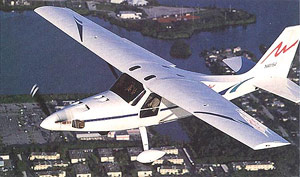COMP AIR 7 - "Performance That Knocks Your Socks Off"
Text by Norm Goyer -- Photos by Bill Fedorko

Before you start the engine, be sure to apply the parking brake and
stand on the brakes as well, because when those huge props start rotating,
you can really feel the power, and you don't want the plane to roll until
you're ready. To prevent surges, be sure all the power switches and
navaids are off and the circuit breakers are in. Check all the controls to
see if they're free and not binding.
The following is the procedure we used to start this Walter turbine
(one not equipped with an auto-start assembly): Check the fuel valve once
more to make sure it's on. See that all circuit breakers are in and that
the generator is off. Pull the start lever on the power quadrant full aft
to 'fuel cut off.' Position the propeller lever in the full-feather
position. The last power quadrant lever is the power lever, which is
placed in the idle position. Now you're ready to go. With one hand on the
power level, use the other hand to turn on the master switch. Check the
voltage to make sure there's at least 24.5 volts. To be absolutely sure,
press the two test lights-one marked beta, the other marked limiter. Check
the two igniters, one and two, then shut them off again. Now start the
fuel boost pump and check to make sure there's at least 15 pounds per
square inch. Then clear the prop area.
It's time to hit the starter switch. When the gauge shows N1, move the
fuel lever to the start position. Turn both igniters on, and torch the
engine on for two seconds, then off for two seconds. You must also monitor
the ITT heat gauge to make sure it does not exceed 735 degrees, and keep the starter
engaged until the engine reaches an N1 of 45 percent. Scan the oil
pressure and temperature. When you've made sure the engine has reached 45
percent N1, you can release the starter. The next
step is to check and see if the engine accelerates smoothly to 60 percent
N1. Check again to make
sure that you have
not exceeded 735 degrees. If the engine does reach 735, you must pull the
start lever to ICO (ignition cutoff) until the ITT drops below 650
degrees. This is the dreaded hot start that must be avoided to prevent
damage to the engine. If the engine is running smoothly and all
temperatures are in the green, you can switch the generator on, then
switch the
12-volt buss on for the avionics. Make sure
the radios and intercom are working correctly. Next, check the vacuum
pump, strobes, beacons and lights.
It's finally time to taxi. The
previous instructions might sound complicated, but they're really not.
(They're similar to the start procedures of any high performance aircraft
with a constant speed prop.)
Release the parking brake, and use the prop
beta control as the throttle. Avoid using too much brake or depending on
the throttle; you have better and faster control with the prop lever.
You're about to go for the wildest ride you've ever had -- unless you're
an Air Force pilot flying an F-15 Eagle - and even then, the Comp Air 7
still has it beat on the takeoff run.
Takeoff is the same as with any high-performance taildragger, but with
just a few more checks to make before you start the takeoff roll. Place
the flaps 10 to 15 degrees down, recheck the fuel quantity and valve
position, and make absolutely sure the fuel
boost pump is on. Then, cycle the prop once
or twice with the power lever in the idle position. Check one more time to
make sure the power lever is in the run position. Set the power to 30
percent and slowly move the prop lever to the aft position, so you can
check that the rpm are decreasing gradually. Now move the prop lever to
the full-forward high-rpm position.
|